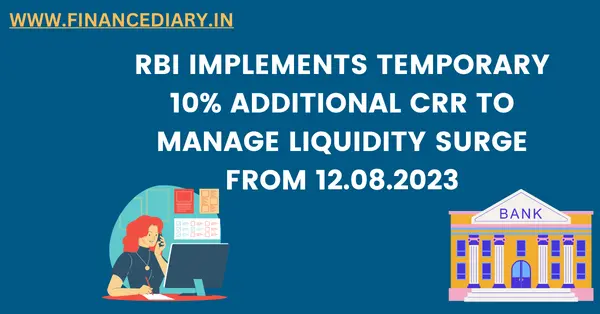The Reserve Bank of India (RBI) has taken significant steps to manage liquidity in the banking system, announcing a temporary measure of maintaining an incremental cash reserve ratio (ICRR) of 10 percent, effective August 12. This move comes in response to the withdrawal of the Rs 2,000 currency note and aims to stabilize financial and price conditions. Let’s delve into the details of this development and its implications.
RBI KEEPS REPO RATE UNCHANGED
In its latest policy announcement on August 10, the RBI decided to retain the repo rate at 6.5 percent. This decision was made by the Monetary Policy Committee (MPC) with the goal of maintaining financial stability and effective liquidity management.
INTRODUCTION OF INCREMENTAL CRR (ICRR)
In response to the withdrawal of the Rs 2,000 note, the RBI has introduced the concept of incremental cash reserve ratio (ICRR). The ICRR requires banks to maintain an additional 10 percent reserve, temporarily absorbing excess liquidity from the system. This measure aims to ensure financial stability while allowing banks to continue their lending operations effectively.
TEMPORARY NATURE OF ICRR
RBI Governor Das emphasized that the ICRR imposition is purely temporary and was deemed necessary to address the liquidity overhang. He highlighted that this measure is essential for financial and price stability and is likely to impact inflation. The central bank assures that this is a short-term strategy to manage the current liquidity situation.
EXPERT INSIGHTS ON ICRR IMPLICATIONS
Economists have weighed in on the potential impact of ICRR. Madan Sabnavis, an Economist at Bank of Baroda, notes that while temporary, ICRR could tighten banks’ resources and influence market rates upward. Meanwhile, Madhavi Arora, Chief Economist at Emkay Global, points out that ICRR imposition could result in a temporary liquidity reduction of approximately Rs1.15 trillion, assuming an effective CRR of 14.5 percent during the concerned period.
CLARITY ON ICRR INCLUSION
Arora also highlights the need for clarity regarding the inclusion of existing CRR in ICRR calculations. While awaiting further details from the RBI’s press conference, Arora suggests that the inclusion of the existing CRR of 4.5 percent could result in a liquidity reduction of around Rs650 billion. This underscores the importance of clear communication to accurately understand the implications of ICRR.
COMPARATIVE ANALYSIS
The RBI’s decision to introduce ICRR is not without precedent. In November 2016, the central bank imposed an ICRR equivalent to 100 percent of the increase in net demand and time liabilities (NDTL) of scheduled banks. This earlier measure aimed to absorb excess liquidity following the withdrawal of Rs 500 and Rs 1,000 denomination bank notes.
MPC’S UNIFIED STANCE
The Monetary Policy Committee’s unanimous decision to maintain the repo rate at 6.5 percent reflects a cohesive approach to stabilize the economy and manage liquidity. The MPC’s decision also includes the retention of the Standing Deposit Facility rate at 6.25 percent and the Marginal Standing Facility rate and Bank Rate at 6.75 percent.
IMPACT ON MARKETS
Financial markets responded predictably to the RBI’s policy announcement. The yield on the benchmark 10-year government bond and the exchange rate of the rupee against the US dollar remained stable. Market players anticipate potential changes in yield on treasury bills due to the ICRR measure, awaiting clarity on its implementation.
CONCLUSION
The RBI’s implementation of the temporary 10 percent ICRR is a strategic move aimed at controlling excess liquidity in the banking system. This measure is expected to have a moderate impact on market rates while ensuring banks have sufficient liquidity to continue lending operations. As the central bank remains committed to financial stability and effective monetary policy, ongoing communication and transparency will play a crucial role in understanding and adapting to these changes.
